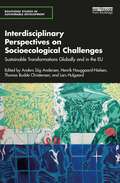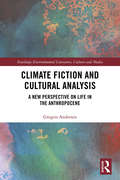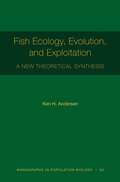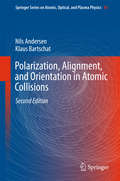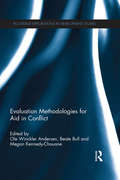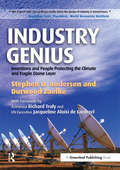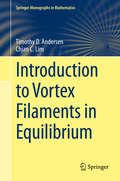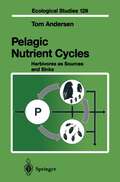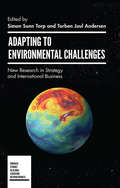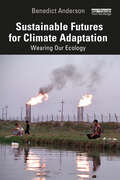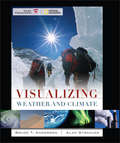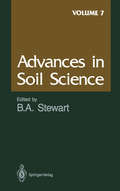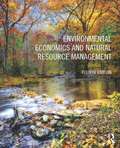- Table View
- List View
Interdisciplinary Perspectives on Socioecological Challenges: Sustainable Transformations Globally and in the EU (Routledge Studies in Sustainable Development)
by Anders Siig Andersen Henrik Hauggaard-Nielsen Thomas Budde Christensen Lars HulgaardThis book explores interdisciplinary perspectives on socioecological challenges and offers innovative solutions at both a European and global level. This book critically reflects on the latest scientific knowledge regarding the increasing instability of the Earth System caused by human activities during the Anthropocene and the Great Acceleration. It focuses on the global and European challenges regarding climate, resources, bio-integrity, and environment. The authors assess the obstacles to overcoming these challenges and examine the risks posed by path dependencies, lock-ins, and trade-offs between global and regional goals. They also drill down into the complexities of the European Green Deal, specifically the similarities and differences between the scientific analyses and recommendations from the European Environment Agency and the content of the Deal. Finally, the book looks at the Just Transition put forward by the European Green Deal. The authors discuss this in a context of global and European ecological and socioecological challenges and put the question of equality, recognition, and democratization at the center. Outlining new pathways to broaden the scope of scientific collaboration between the natural and technical sciences and the social sciences and the humanities, this volume will be of great interest to students and scholars of sustainable development, environmental policy and governance, and environmental justice.
Borderlands Resilience: Transitions, Adaptation and Resistance at Borders (Border Regions Series)
by Dorte Jagetic Andersen Eeva-Kaisa ProkkolaThis book offers new insights into the current, highly complex border transitions taking place at the EU internal and external border areas, as well as globally. It focuses on new frontiers and intersections between borders, borderlands and resilience, developing new understandings of resilience through the prism of borders. The book provides new perspectives into how different groups of people and communities experience, adapt and resist the transitions and uncertainties of border closures and securitization in their everyday and professional lives. The book also provides new methodological guidelines for the study of borders and multi-sited bordering and resilience processes. The book bridges border studies and social scientific resilience research in new and innovative. It will be of interest to students and scholars in geography, political studies, international relations, security studies and anthropology.
Borderlands Resilience: Transitions, Adaptation and Resistance at Borders (Border Regions Series)
by Dorte Jagetic Andersen Eeva-Kaisa ProkkolaThis book offers new insights into the current, highly complex border transitions taking place at the EU internal and external border areas, as well as globally. It focuses on new frontiers and intersections between borders, borderlands and resilience, developing new understandings of resilience through the prism of borders. The book provides new perspectives into how different groups of people and communities experience, adapt and resist the transitions and uncertainties of border closures and securitization in their everyday and professional lives. The book also provides new methodological guidelines for the study of borders and multi-sited bordering and resilience processes. The book bridges border studies and social scientific resilience research in new and innovative. It will be of interest to students and scholars in geography, political studies, international relations, security studies and anthropology.
Climate Fiction and Cultural Analysis: A new perspective on life in the anthropocene (Routledge Environmental Literature, Culture and Media)
by Gregers AndersenClimate Fiction and Cultural Analysis argues that the popularity of the term "climate fiction" has paradoxically exhausted the term’s descriptive power and that it has developed into a black box containing all kinds of fictions which depict climatic events and has consequently lost its true significance. Aware of the prospect of ecological collapse as well as our apparent inability to avert it, we face geophysical changes of drastic proportions that severely challenge our ability to imagine the consequences. This book argues that this crisis of imagination can be partly relieved by climate fiction, which may help us comprehend the potential impact of the crisis we are facing. Strictly assigning "climate fiction" to fictions that incorporate the climatological paradigm of anthropogenic global warming into their plots, this book sets out to salvage the term’s speculative quality. It argues that climate fiction should be regarded as no less than a vital supplement to climate science, because climate fiction makes visible and conceivable future modes of existence within worlds not only deemed likely by science, but which are scientifically anticipated. Focusing primarily on English and German language fictions, Climate Fiction and Cultural Analysis shows how Western climate fiction sketches various affective and cognitive relations to the world in its utilization of a small number of recurring imaginaries, or imagination forms. This book will be of great interest to students and scholars of ecocriticism, the environmental humanities, and literary and culture studies more generally.
Climate Fiction and Cultural Analysis: A new perspective on life in the anthropocene (Routledge Environmental Literature, Culture and Media)
by Gregers AndersenClimate Fiction and Cultural Analysis argues that the popularity of the term "climate fiction" has paradoxically exhausted the term’s descriptive power and that it has developed into a black box containing all kinds of fictions which depict climatic events and has consequently lost its true significance. Aware of the prospect of ecological collapse as well as our apparent inability to avert it, we face geophysical changes of drastic proportions that severely challenge our ability to imagine the consequences. This book argues that this crisis of imagination can be partly relieved by climate fiction, which may help us comprehend the potential impact of the crisis we are facing. Strictly assigning "climate fiction" to fictions that incorporate the climatological paradigm of anthropogenic global warming into their plots, this book sets out to salvage the term’s speculative quality. It argues that climate fiction should be regarded as no less than a vital supplement to climate science, because climate fiction makes visible and conceivable future modes of existence within worlds not only deemed likely by science, but which are scientifically anticipated. Focusing primarily on English and German language fictions, Climate Fiction and Cultural Analysis shows how Western climate fiction sketches various affective and cognitive relations to the world in its utilization of a small number of recurring imaginaries, or imagination forms. This book will be of great interest to students and scholars of ecocriticism, the environmental humanities, and literary and culture studies more generally.
Fish Ecology, Evolution, and Exploitation: A New Theoretical Synthesis (Monographs in Population Biology #93)
by Ken H. AndersenFish are one of the most important global food sources, supplying a significant share of the world’s protein consumption. From stocks of wild Alaskan salmon and North Sea cod to entire fish communities with myriad species, fisheries require careful management to ensure that stocks remain productive, and mathematical models are essential tools for doing so. Fish Ecology, Evolution, and Exploitation is an authoritative introduction to the modern size- and trait-based approach to fish populations and communities.Ken Andersen covers the theoretical foundations, mathematical formulations, and real-world applications of this powerful new modeling method, which is grounded in the latest ecological theory and population biology. He begins with fundamental assumptions on the level of individuals and goes on to cover population demography and fisheries impact assessments. He shows how size- and trait-based models shed new light on familiar fisheries concepts such as maximum sustainable yield and fisheries selectivity—insights that classic age-based theory can’t provide—and develops novel evolutionary impacts of fishing. Andersen extends the theory to entire fish communities and uses it to support the ecosystem approach to fisheries management, and forges critical links between trait-based methods and evolutionary ecology.Accessible to ecologists with a basic quantitative background, this incisive book unifies the thinking in ecology and fisheries science and is an indispensable reference for anyone seeking to apply size- and trait-based models to fish demography, fisheries impact assessments, and fish evolutionary ecology.
Polarization, Alignment, and Orientation in Atomic Collisions (Springer Series on Atomic, Optical, and Plasma Physics #96)
by Nils Andersen Klaus BartschatThis book covers polarization, alignment, and orientation effects in atomic collisions induced by electron, heavy particle, or photon impact. The first part of the book presents introductory chapters on light and particle polarization, experimental and computational methods, and the density matrix and state multipole formalism. Examples and exercises are included. The second part of the book deals with case studies of electron impact and heavy particle excitation, electron transfer, impact ionization, and autoionization. A separate chapter on photo-induced processes by new-generation light sources has been added. The last chapter discusses related topics and applications. Part III includes examples of charge clouds and introductory summaries of selected seminal papers of tutorial value from the early history of the field (1925 – 1975).The book is a significant update to the previous (first) edition, particularly in experimental and computational methods, the inclusion of key results obtained during the past 15 years, and the extended coverage of photo-induced processes. It is intended as an introductory text for both experimental and theoretical students and researchers. It can be used as a textbook for graduate courses, as a primary source for special topics and seminar courses, and as a standard reference.The book is accompanied by electronically available copies of the full text of the key papers in Part III, as well as animations of theoretically predicted electron charge clouds and currents for some of the cases discussed in Part II.
Evaluation Methodologies for Aid in Conflict (Routledge Explorations in Development Studies)
by Ole Winckler Andersen Beate Bull Megan Kennedy-ChouaneKnowledge and rigorous evidence around the role of external development partners in situations of conflict and fragility is still lacking. There is little accountability for the billions in aid being spent in places like Afghanistan, Iraq and the Democratic Republic of Congo. This book analyses evaluation theory and practice in order to help fill this knowledge gap and advocates a realistic and rigorous approach to evaluating international engagement. Through a series of case studies, this book highlights both the promise, and potential pitfalls, of taking a more evaluative approach to understanding aid in conflict regions. These illustrate the methodological and analytical approach taken by researchers working to understand the results and effectiveness of conflict prevention and peacebuilding support. While well-grounded in current theoretical and methodological debates, the book provides valuable practical information by examining how and why different choices were made in the context of each evaluation. The book shows what future steps may be envisaged to further strengthen evaluations of support for conflict prevention and peacebuilding. The analysis draws on a wealth of perspectives and voices to provide researchers and students in development studies and conflict and peace studies as well as development evaluators with a deep and broad understanding of evaluation methods and approaches.
Evaluation Methodologies for Aid in Conflict (Routledge Explorations in Development Studies)
by Ole Winckler Andersen Beate Bull Megan Kennedy-ChouaneKnowledge and rigorous evidence around the role of external development partners in situations of conflict and fragility is still lacking. There is little accountability for the billions in aid being spent in places like Afghanistan, Iraq and the Democratic Republic of Congo. This book analyses evaluation theory and practice in order to help fill this knowledge gap and advocates a realistic and rigorous approach to evaluating international engagement. Through a series of case studies, this book highlights both the promise, and potential pitfalls, of taking a more evaluative approach to understanding aid in conflict regions. These illustrate the methodological and analytical approach taken by researchers working to understand the results and effectiveness of conflict prevention and peacebuilding support. While well-grounded in current theoretical and methodological debates, the book provides valuable practical information by examining how and why different choices were made in the context of each evaluation. The book shows what future steps may be envisaged to further strengthen evaluations of support for conflict prevention and peacebuilding. The analysis draws on a wealth of perspectives and voices to provide researchers and students in development studies and conflict and peace studies as well as development evaluators with a deep and broad understanding of evaluation methods and approaches.
Industry Genius: Inventions and People Protecting the Climate and Fragile Ozone Layer
by Stephen Andersen Durwood ZaelkeThis book presents the inventive genius behind technological breakthroughs by ten global companies including Alcoa, DaimlerChrysler, Honda, ST Micro and Visteon. Readers will gain understanding and insight into how cutting-edge technology is helping protect the climate and/or the ozone layer, while contributing to the company's bottom line. Each chapter chronicles the challenge and triumph of invention, introduces the engineers and executives who overcome conventional wisdom, and demonstrates the contribution these companies are making to environmental protection. In full colour and crammed with graphics to illustrate the creative process of technological breakthroughs, the book is accessible and informative. The genius of these ten companies will inspire the engineer, the policy-maker, the student, the environmentalist, the CEO and the investor alike.
Introduction to Vortex Filaments in Equilibrium (Springer Monographs in Mathematics)
by Timothy D. Andersen Chjan C. LimThis book presents fundamental concepts and seminal results to the study of vortex filaments in equilibrium. It also presents new discoveries in quasi-2D vortex structures with applications to geophysical fluid dynamics and magnetohydrodynamics in plasmas. It fills a gap in the vortex statistics literature by simplifying the mathematical introduction to this complex topic, covering numerical methods, and exploring a wide range of applications with numerous examples. The authors have produced an introduction that is clear and easy to read, leading the reader step-by-step into this topical area. Alongside the theoretical concepts and mathematical formulations, interesting applications are discussed. This combination makes the text useful for students and researchers in mathematics and physics.
Pelagic Nutrient Cycles: Herbivores as Sources and Sinks (Ecological Studies #129)
by Tom AndersenAn analysis of the interactions between pelagic food web processes and element cycling in lakes. While some findings are examined in terms of classical concepts from the ecological theory of predator-prey systems, special emphasis is placed on exploring how stoichiometric relationships between primary producers and herbivores influence the stability and persistence of planktonic food webs. The author develops simple dynamic models of the cycling of mineral nutrients through plankton algae and grazers, and then goes on to explore them both analytically and numerically. The results thus obtained are of great interest to both theoretical and experimental ecologists. Moreover, the models themselves are of immense practical use in the area of lake management.
Strategic Responses for a Sustainable Future: New Research in International Management (Emerald Studies in Global Strategic Responsiveness)
by Torben Juul AndersenThe past decade has seen global business conditions affected by major socio-economic crises. These have highlighted a pressing need to build resilient organizational structures with effective responsive processes. Businesses are more exposed to uncertain and unknown factors, as well as significant environmental exposures, making the call for resilient and responsive capabilities ever more urgent. The ability to engage in responsive strategy-making under rapid and potentially extreme environmental changes requires a leadership approach that prioritises specialized experiential knowledge of internal and external stakeholders and a capacity to develop organizational settings that enable collaborative ways of working. Strategic Responses for a Sustainable Future considers how modern organizations can respond to deal with increasingly uncertain environmental conditions. Chapters cover adaptive processes to enhance responsiveness, the adoption of green and open strategies, as well as “maverick” methods of resource management and driving innovation, all with the aim of creating effective solutions that can sustain business growth and performance.
Strategic Responses for a Sustainable Future: New Research in International Management (Emerald Studies in Global Strategic Responsiveness)
by Torben Juul AndersenThe past decade has seen global business conditions affected by major socio-economic crises. These have highlighted a pressing need to build resilient organizational structures with effective responsive processes. Businesses are more exposed to uncertain and unknown factors, as well as significant environmental exposures, making the call for resilient and responsive capabilities ever more urgent. The ability to engage in responsive strategy-making under rapid and potentially extreme environmental changes requires a leadership approach that prioritises specialized experiential knowledge of internal and external stakeholders and a capacity to develop organizational settings that enable collaborative ways of working. Strategic Responses for a Sustainable Future considers how modern organizations can respond to deal with increasingly uncertain environmental conditions. Chapters cover adaptive processes to enhance responsiveness, the adoption of green and open strategies, as well as “maverick” methods of resource management and driving innovation, all with the aim of creating effective solutions that can sustain business growth and performance.
Adapting to Environmental Challenges: New Research in Strategy and International Business (Emerald Studies in Global Strategic Responsiveness)
by Torben Juul Andersen Simon Sunn TorpThe global business environment is as turbulent as ever and organizations must adapt to the changing conditions to survive and persevere. Adapting To Environmental Challenges: New Research In Strategy And International Business provides new promising insights on the effects of middle management involvement in adaptive strategy-making processes and applications of interactive control systems in the pursuit of more durable corporate outcomes. The empirical evidence suggests that responsible corporate behaviour drives higher market-valuations of firms and the application of green technologies is associated with more sustainable performance outcomes. For international organizations that operate across a multiplicity of cultural contexts, the ability to manage responsible corporate behavior must be interpreted in the local contexts and not only in a headquarter context, which is the norm. Hence, multinational managers must appreciate and understand the cultural differences to disentangle the managerial challenges in dynamic global markets where resource-poor firms can forge their international market positions by offering advantageous value-to-price trade-offs induced by supportive cultural values. Adapting To Environmental Challenges: New Research In Strategy And International Business provide new relevant perspectives and insights to understand strategic adaptation in international business contexts based on corporate responsible behavior and cultural sensitivity as the ingredients for agile operations and a resilient multinational organization.
An Introduction to Frozen Ground Engineering
by Orlando B. Andersland B. LadanyiFrozen Ground Engineering first introduces the reader to the frozen environment and the behavior of frozen soil as an engineering material. In subsequent chapters this information is used in the analysis and design of ground support systems, foundations, and embankments. These and other topics make this book suitable for use by civil engineering students in a one-semester course on frozen ground engineering at the senior or first-year-graduate level. Students are assumed to have a working knowledge of undergraduate mechanics (statics and mechanics of materials) and geotechnical engineering (usual two-course sequence). A knowledge of basic geology would be helpful but is not essential. This book will also be useful to advanced students in other disciplines and to engineers who desire an introduction to frozen ground engineering or references to selected technical publications in the field. BACKGROUND Frozen ground engineering has developed rapidly in the past several decades under the pressure of necessity. As practical problems involving frozen soils broadened in scope, the inadequacy of earlier methods for coping became increasingly apparent. The application of ground freezing to geotechnical projects throughout the world continues to grow as significant advances have been made in ground freezing technology. Freezing is a useful and versatile technique for temporary earth support, groundwater control in difficult soil or rock strata, and the formation of subsurface containment barriers suitable for use in groundwater remediation projects.
Sustainable Futures for Climate Adaptation: Wearing Our Ecology
by Benedict AndersonConsidering sustainability as a flawed and restrictive term in practice, Sustainable Futures for Climate Adaptation argues that we must radically adapt humanity and reform society, cities, buildings, and our approach to migration in order to coexist in harmony with our natural environments. The book conceives an Earth–human coexistence where the world’s regions are shared globally between all people, in contrast to a reality where we have lost touch with the natural world. It is this decoupling of humanity and nature that has brought us to the brink of climate disaster. In response, Benedict Anderson explores the concept of ‘wearing our ecology’, where human mobility is synchronized with the environment, merging people with landscapes, topographies, and geographies. Anderson argues that we need to create new migration routes for people moving between the Global South and North and establish flexible and adaptive living environments. Only by rethinking separations between urban and rural, resource extraction and consumption, racial prejudice and accessibility are we able to forge a closer partnership with nature to adapt to climate change and mitigate the worst of its effects. Touching on themes of adaptive urban design, racial and gender segregation and inequality, and climate apocalypticism, this book will be valuable reading for researchers, scholars, and upper-level students in the fields of urban studies, migration studies, human geography, ecology, politics, and design.
Sustainable Futures for Climate Adaptation: Wearing Our Ecology
by Benedict AndersonConsidering sustainability as a flawed and restrictive term in practice, Sustainable Futures for Climate Adaptation argues that we must radically adapt humanity and reform society, cities, buildings, and our approach to migration in order to coexist in harmony with our natural environments. The book conceives an Earth–human coexistence where the world’s regions are shared globally between all people, in contrast to a reality where we have lost touch with the natural world. It is this decoupling of humanity and nature that has brought us to the brink of climate disaster. In response, Benedict Anderson explores the concept of ‘wearing our ecology’, where human mobility is synchronized with the environment, merging people with landscapes, topographies, and geographies. Anderson argues that we need to create new migration routes for people moving between the Global South and North and establish flexible and adaptive living environments. Only by rethinking separations between urban and rural, resource extraction and consumption, racial prejudice and accessibility are we able to forge a closer partnership with nature to adapt to climate change and mitigate the worst of its effects. Touching on themes of adaptive urban design, racial and gender segregation and inequality, and climate apocalypticism, this book will be valuable reading for researchers, scholars, and upper-level students in the fields of urban studies, migration studies, human geography, ecology, politics, and design.
Visualizing Weather and Climate (Visualizing Series)
by Bruce Anderson Alan H. StrahlerVisualizing Weather and Climate offers students a valuable opportunity to identify and connect the central issues of weather, climate, and the atmosphere through a visual approach. The text is organized around the premise that weather and climate are two interrelated and equally important influences upon environmental processes and human activity. As students explore the critical topics of weather and climate, their study of the role of the atmosphere is interwoven with the behavior of the oceans, land surfaces, ecosystems, and human activity. Visualizing Weather and Climate integrates visuals with text to elucidate concepts for students and solidify their understanding of them. The accessible format allows students to navigate through the material with greater ease.
Ni-Co 2021: The 5th International Symposium on Nickel and Cobalt (The Minerals, Metals & Materials Series)
by Corby Anderson Graeme Goodall Sumedh Gostu Dean Gregurek Mari Lundström Christina Meskers Stuart Nicol Esa Peuraniemi Fiseha Tesfaye Prabhat K. Tripathy Shijie Wang Yuanbo ZhangIn this volume, operators, engineers, and researchers present information about all aspects of current processing technologies for nickel and cobalt, as well as emerging technologies for both metals. Contributions from industry and academia encompass metallurgical aspects of metals commonly associated with nickel and cobalt, such as copper and platinum group metals (PGMs). Specific focus areas of the collection include, but are not limited to mineral processing, metallurgy of nickel and cobalt ores, battery materials, recycling, recovery of associated byproducts and PGMs, and sulfide and laterite processing.
Advances in Soil Science (Advances in Soil Science #7)
by D. W. Anderson E. Bresler W. W. Frye L. Metzger M. S. Smith J. J. Varco J. Venkateswarlu B. YaronThe world population in 1950 was 2. 5 billion and is more than 5 billion today. The agriculture community, however, has responded remarkably well to meeting the increased need for food and fiber. While the population growth during this period averaged almost 2% annually, the production of grain increased at an even faster rate. From 1950 to 1973, grain production increased 3. 1% annually, but slowed to about 2% from 1973 to 1984. There fore, as a whole, the world has more grain per capita available today than ever before. Several countries that were food importers just a few years ago are food exporters today. The world carry-over stocks today are the highest in years. While the major concern just a few years ago was whether the world could produce adequate food, the problem for many countries today is how to export their surpluses. Although the world as a whole has surplus food supplies, there are millions of people without adequate food to exist, and there are additional millions who have a bare subsistence diet at best. The average daily calorie supply for the developed countries is more than 3,300 per person, while the average for the developing countries is only about 2,200. The major global food produc tion problems have shifted from Asia to Africa, where malnutrition, poverty, and starvation are attracting world attention.
Environmental Economics and Natural Resource Management
by David A. AndersonThe tools of environmental economics guide policymakers as they weigh development against nature, present against future, and certain benefits against uncertain consequences. From reluctant-but-necessary calculations of the value of life, to quandaries over profits at the environment’s expense, the policies and research findings explained in this textbook are relevant to decisions made daily by individuals, firms, and governments. The fourth edition of Environmental Economics and Natural Resource Management pairs the user-friendly approaches of the previous editions with the latest developments in the field. A story-based narrative delivers clear, concise coverage of contemporary policy initiatives. To promote environmental and economic literacy, we have added even more visual aids, including color photographs and diagrams unmatched in other texts. Ancillaries include an Instructor’s Guide with answers to all of the practice problems and downloadable slides of figures and tables from the book. The economy is a subset of the environment, from which resources are obtained, workers and consumers receive sustenance, and life begins. Energy prices and environmental calamities constrain economic growth and the quality of life. The same can be said about overly restrictive environmental policies. It is with an appreciation for the weighty influence of this discipline, and the importance of conveying it to students, that this textbook is crafted.
Environmental Economics and Natural Resource Management: And Natural Resource Management
by David A. AndersonThe tools of environmental economics guide policymakers as they weigh development against nature, present against future, and certain benefits against uncertain consequences. From reluctant-but-necessary calculations of the value of life, to quandaries over profits at the environment’s expense, the policies and research findings explained in this textbook are relevant to decisions made daily by individuals, firms, and governments. The fourth edition of Environmental Economics and Natural Resource Management pairs the user-friendly approaches of the previous editions with the latest developments in the field. A story-based narrative delivers clear, concise coverage of contemporary policy initiatives. To promote environmental and economic literacy, we have added even more visual aids, including color photographs and diagrams unmatched in other texts. Ancillaries include an Instructor’s Guide with answers to all of the practice problems and downloadable slides of figures and tables from the book. The economy is a subset of the environment, from which resources are obtained, workers and consumers receive sustenance, and life begins. Energy prices and environmental calamities constrain economic growth and the quality of life. The same can be said about overly restrictive environmental policies. It is with an appreciation for the weighty influence of this discipline, and the importance of conveying it to students, that this textbook is crafted.
Environmental Economics and Natural Resource Management
by David A. AndersonThe tools of environmental economics guide policymakers as they weigh development against nature, present against future, and certain benefits against uncertain consequences. The policies and research findings explained in this textbook are relevant to decisions made daily by individuals, firms, and governments. This textbook offers instructors and students a user-friendly, relevant, and up-to-date introduction to these topics while covering recent advancements in the field and significant political and economic changes. The fifth edition has been thoroughly updated while retaining the story-based narratives and visual emphasis of previous editions, capturing students’ attention with full-color photos, graphs, and illustrations. It addresses the impact of changes in world leaders, national priorities, and international agreements along with key developments in the energy sector. These include the way hydraulic fracturing and the surging popularity of natural gas have revolutionized the fossil fuel industries; how new, green-energy technologies are bringing prices down and efficiency levels up; and the arrival of innovative energy sources such as ocean-thermal energy conversion. Environmental Economics and Natural Resource Management promotes environmental and economic literacy with policy-oriented, application-based content, all delivered in concise, accessible discussions. Through its engaging approach, the text brings the economic way of thinking into discussions of personal, community, corporate, and government activities that affect environmental assets and the quality of life.
Environmental Economics and Natural Resource Management
by David A. AndersonThe tools of environmental economics guide policymakers as they weigh development against nature, present against future, and certain benefits against uncertain consequences. The policies and research findings explained in this textbook are relevant to decisions made daily by individuals, firms, and governments. This textbook offers instructors and students a user-friendly, relevant, and up-to-date introduction to these topics while covering recent advancements in the field and significant political and economic changes. The fifth edition has been thoroughly updated while retaining the story-based narratives and visual emphasis of previous editions, capturing students’ attention with full-color photos, graphs, and illustrations. It addresses the impact of changes in world leaders, national priorities, and international agreements along with key developments in the energy sector. These include the way hydraulic fracturing and the surging popularity of natural gas have revolutionized the fossil fuel industries; how new, green-energy technologies are bringing prices down and efficiency levels up; and the arrival of innovative energy sources such as ocean-thermal energy conversion. Environmental Economics and Natural Resource Management promotes environmental and economic literacy with policy-oriented, application-based content, all delivered in concise, accessible discussions. Through its engaging approach, the text brings the economic way of thinking into discussions of personal, community, corporate, and government activities that affect environmental assets and the quality of life.
